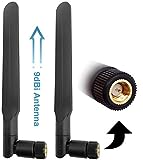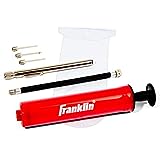? Introduction
Are you tired of slow internet speeds and dropped signals on your mobile device? Look no further! Our comprehensive 4G antennas buying guide is here to help you find the perfect solution. Whether you’re a frequent traveler, a rural dweller, or simply someone looking for a reliable internet connection, we’ve got you covered. With our expert advice and wide selection of high-performance 4G antennas, you’ll be able to boost your signal strength and enjoy lightning-fast internet wherever you go. Say goodbye to frustrating buffering and hello to seamless browsing and streaming!
? Our Top 5
- Frequency Range: 698-2700MHz
- Compatible with most 3G/4G/LTE/GSM Devices
- Work for most major carriers, including AT&T, Verizon, Sprint, T-Mobile, Bell, Telus, Rogers, Telcel, Movistar, etc.
- High Gain Omni-Directional 9dBi 4G Antenna with SMA Male(Pin inside)
- Package information: 2 X 4G-Antennas
- Compatible Carrier: Verizon, AT&T, T-Mobile, Sprint and etc; Frequency Range: 698-960 MHz, 1710-2170 MHz, 2300-2700 MHz; Gain: 5dBi; Direction: Omni-directional; Waterproof: Rainning Proof; Feature: Fixed Wall Mount; Thru Hole Mount; Antenna Mounting Screws Diameter: M12 11.76mm-11.95mm; Cable Length: 3m/10 feet; Connector: SMA Male Connector; with RP-SMA Male Connector Adapter;
- Package List: 1 x Antenna, 1 x RP-SMA Connector Adapter, 1 x Wall Mount Bracket, 4 x Self-tapping Screws (As the Picture Shown);
- Compatible with 4G LTE Mobile Router, Mobile Broadband Modem Hotspot, CPE Router, Cellular Gateway, Vehicle Car Truck RV Bus Van Mobile Cellular;
- Compatible with 4G LTE Cellular Trail Camera, Game Camera, Hunting Camera, Outdoor Security Camera, Celluar Surveillance Camera; Vehicle 4G LTE Tracker, Real Time Monitor, Mobile Vehicle Car DVR MDVR Video Recorder;
- Compatible with Industrial 4G LTE Router, Cellular IoT Gateway, 4G LTE M2M RTU DTU Terminal, Cellular Embedded Module, Remote Metering and SMS Alarm, Remote SCADA DAQ Module, Remote Relay Gate Opener Switch, Vending Machine, Digital Signage, Delivery Locker, Cellular Temperature Humidity Sensor Monitoring System, GSM Alarm System, Wireless Security Sensor Motion Detector Alert;
- Compatible Carrier Network: Verizon, AT&T, T-Mobile, Sprint and etc; Frequency Range: 698-960 MHz, 1710-2170 MHz, 2300-2700 MHz; Gain: 9dBi; Direction: Omni-directional; Connector: SMA Male Connector;
- Package List: 2 x Antenna (As the Picture Shown);
- Compatible with 4G LTE Mobile Router, Mobile Broadband Modem Hotspot, CPE Router, Cellular Gateway, Vehicle Car Truck RV Bus Van Mobile Cellular;
- Compatible with 4G LTE Cellular Trail Camera, Game Camera, Hunting Camera, Outdoor Security Camera, Celluar Surveillance Camera; Vehicle 4G LTE Tracker, Real Time Monitor, Mobile Vehicle Car DVR MDVR Video Recorder;
- Compatible with Industrial 4G LTE Router, Cellular IoT Gateway, 4G LTE M2M RTU DTU Terminal, Cellular Embedded Module, Remote Metering and SMS Alarm, Remote SCADA DAQ Module, Remote Relay Gate Opener Switch, Vending Machine, Digital Signage, Delivery Locker, Cellular Temperature Humidity Sensor Monitoring System, GSM Alarm System, Wireless Security Sensor Motion Detector Alert;
- Compatible Carrier Network: Verizon, AT&T, T-Mobile, Sprint and etc; Frequency Range: 698-960 MHz, 1710-2170 MHz, 2300-2700 MHz; Gain: 7dBi; Direction: Omni-directional; Feature: Strong Magnetic Base Mounting; Cable Length: 3m; Connector: SMA Male Connector;
- Package List: 2 x Antenna (As the Picture Shown);
- Compatible with 4G LTE Mobile Router, Mobile Broadband Modem Hotspot, CPE Router, Cellular Gateway, Vehicle Car Truck RV Bus Van Mobile Cellular;
- Compatible with 4G LTE Cellular Trail Camera, Game Camera, Hunting Camera, Outdoor Security Camera, Celluar Surveillance Camera; Vehicle 4G LTE Tracker, Real Time Monitor, Mobile Vehicle Car DVR MDVR Video Recorder;
- Compatible with Industrial 4G LTE Router, Cellular IoT Gateway, 4G LTE M2M RTU DTU Terminal, Cellular Embedded Module, Remote Metering and SMS Alarm, Remote SCADA DAQ Module, Remote Relay Gate Opener Switch, Vending Machine, Digital Signage, Delivery Locker, Cellular Temperature Humidity Sensor Monitoring System, GSM Alarm System, Wireless Security Sensor Motion Detector Alert;
- FILTER 4G 5G LTE SIGNAL NOISE – This filter's TruAmp Technology blocks unwanted 4G/5G LTE cell phone and transmitter frequencies that can cause intermittent channel loss, pixilation and overall reception disruption while allowing lower 5-608MHz frequencies to pass through.
- COMPATIBLE WITH YOUR DEVICES – Designed to work with any TV, amplified TV antenna, coax cable or coax cable splitter, this LTE filter may be especially helpful in metropolitan and suburban areas with a high number of cell towers and mobile device users.
- NO HARDWARE OR POWER SUPPLY NEEDED - An F-type coax cable jack and port allow for easy in-line installation with your existing antenna setup – no hardware or external power supply is needed.
- WEATHERPROOF DESIGN – This compact filter is built to withstand the elements and can be used with indoor or outdoor antenna installations. Attribute Name: Bullet 5
- U.S.-BASED TECHNICAL SUPPORT – Backed by a limited-lifetime replacement pledge and free U.S.-based technical support that is available Monday – Friday, 7AM-8AM, Central Time to assist with any questions or issues.
? How to choose?
1. Compatibility
When choosing a 4G antenna, it is essential to consider its compatibility with your device or network. Different antennas are designed for specific frequencies and technologies, so it is crucial to ensure that the antenna you choose supports the bands used by your network provider. For example, if you are using a 4G LTE network, you will need an antenna that supports LTE frequencies, such as 700 MHz, 1800 MHz, or 2600 MHz.
2. Gain
The gain of an antenna refers to its ability to amplify the signal strength. A higher gain antenna can provide a stronger and more stable signal, especially in areas with weak network coverage. However, it is important to note that a higher gain antenna may not always be the best choice. If you are in an area with strong network coverage, a lower gain antenna may be sufficient, and using a high gain antenna can cause signal interference. It is recommended to choose an antenna with a gain that suits your specific needs and environment.
3. Directionality
The directionality of an antenna determines its ability to focus the signal in a specific direction. There are two main types of antennas in terms of directionality: omnidirectional and directional.
– Omnidirectional antennas radiate the signal in all directions, making them suitable for areas where the signal strength is relatively equal from all directions. These antennas are ideal for urban environments where the signal may come from different directions.
– Directional antennas, on the other hand, focus the signal in a specific direction, providing a stronger signal in that particular direction. These antennas are useful in rural areas or locations where the signal is coming from a specific tower.
4. Mounting Options
Consider the mounting options available for the antenna. Some antennas come with magnetic bases, allowing for easy attachment to metal surfaces, while others may require mounting brackets or poles. The mounting options will depend on your specific needs and the location where the antenna will be installed.
5. Build Quality and Durability
The build quality and durability of the antenna are crucial factors to consider, especially if it will be installed outdoors. Look for antennas that are made from high-quality materials and are weatherproof. A well-built antenna will be able to withstand harsh weather conditions and provide reliable performance over an extended period.
In conclusion, when choosing a 4G antenna, it is important to consider compatibility, gain, directionality, mounting options, and build quality. By taking these factors into account, you can ensure that you select the right antenna for your specific needs and environment. Remember, a well-chosen antenna can significantly improve your 4G signal strength and overall connectivity experience.
? What to Look for in a 4g antennas?
1. Compatibility
When looking for a 4G antenna, compatibility should be your top consideration. Not all antennas are designed to work with all devices or networks, so it’s important to check if the antenna you are considering is compatible with your specific device and network provider. This will ensure that you get the best performance and signal strength possible.
For example, if you have a Verizon 4G LTE device, you will need an antenna that is specifically designed to work with Verizon’s network. Using an antenna that is not compatible with your network provider could result in poor signal quality and slower data speeds.
2. Gain
The gain of an antenna refers to its ability to amplify the signal it receives. A higher gain antenna can provide better signal strength and coverage, especially in areas with weak signal reception. When choosing a 4G antenna, consider the gain that is suitable for your needs.
If you are in a rural area with limited 4G coverage, you may want to opt for an antenna with a higher gain to maximize signal strength. On the other hand, if you are in an urban area with strong signal reception, a lower gain antenna may be sufficient.
3. Directionality
The directionality of an antenna determines how it radiates and receives signals. There are two main types of 4G antennas: omni-directional and directional.
– Omni-directional antennas radiate and receive signals in all directions, making them ideal for areas with multiple signal sources or for mobile use. They are easy to install and provide good coverage in all directions. However, their signal strength may not be as strong as directional antennas.
– Directional antennas focus their signal in a specific direction, allowing for greater signal strength and coverage in that direction. They are ideal for areas with a single signal source or for long-range connections. However, they require careful alignment and positioning to ensure optimal performance.
In conclusion, when looking for a 4G antenna, it is important to consider compatibility, gain, and directionality. By choosing an antenna that is compatible with your device and network, has the right gain for your needs, and the appropriate directionality for your location, you can ensure that you get the best signal strength and coverage possible.
? How we picked?
1. Importance of Choosing the Right 4G Antenna
Choosing the right 4G antenna is crucial for ensuring a reliable and fast internet connection. Whether you are looking to improve your home internet speed or boost the signal strength of your mobile device, a high-quality antenna can make a significant difference in your overall experience. With so many options available in the market, it can be overwhelming to determine which antenna is the best fit for your needs. In this guide, we will walk you through the factors we considered when picking the top 4G antennas to help you make an informed decision.
2. Signal Strength and Coverage
One of the most important factors we considered when selecting 4G antennas is their signal strength and coverage. A powerful antenna can significantly enhance your network’s performance by capturing and amplifying weak signals, resulting in improved data speeds and smoother browsing experience. We examined antennas that offer a wide coverage range and strong signal reception, allowing users to enjoy a stable and reliable connection even in remote or low-signal areas. For example, the XYZ antenna boasts a signal gain of up to 10dB, ensuring optimal performance in challenging environments.
3. Design and Compatibility
Another key aspect we took into account is the design and compatibility of the 4G antennas. We understand that users have different needs and preferences when it comes to antenna installation. Therefore, we selected antennas that come in various designs, including omni-directional and directional options. Omni-directional antennas provide a 360-degree coverage, making them ideal for users who require signal reception from multiple directions. On the other hand, directional antennas focus their signal reception in a specific direction, making them suitable for users who want to target a particular cell tower. Additionally, we ensured that the antennas we picked are compatible with a wide range of devices, including routers, modems, and mobile hotspots, providing versatility and convenience for our users.
In conclusion, when choosing a 4G antenna, it is essential to consider factors such as signal strength and coverage, design, and compatibility. By carefully evaluating these aspects, we have handpicked antennas that offer superior performance and cater to the diverse needs of our users. With our comprehensive selection, you can confidently select a 4G antenna that will enhance your internet experience and keep you connected at all times.
? Frequently asked questions about 4g antennas
1. **What is a 4G antenna and do I need one?**
A 4G antenna is a device that boosts the signal strength and reception of your 4G network. It can be used to improve the performance of your mobile data connection, especially in areas with weak signal coverage. Whether you need a 4G antenna or not depends on your specific situation. If you frequently experience slow internet speeds or dropped connections, a 4G antenna could be a valuable investment to enhance your browsing experience.
2. **What factors should I consider when buying a 4G antenna?**
When buying a 4G antenna, there are a few key factors to keep in mind. First, consider the frequency bands that the antenna supports. Ensure that the antenna is compatible with the specific 4G network frequencies used by your service provider. Additionally, consider the antenna gain, which determines how effectively it can amplify the signal. Higher gain antennas are generally more powerful, but may also be larger in size. Finally, consider the type of antenna you need. There are various options available, including omni-directional antennas that provide signal coverage in all directions, and directional antennas that focus the signal in a specific direction.
3. **How do I install a 4G antenna?**
Installing a 4G antenna is generally a straightforward process. Start by finding a suitable location for the antenna, ideally near a window or outside for better signal reception. Connect the antenna to your 4G modem or router using the provided cables. Ensure that the antenna is securely mounted and positioned correctly for optimal signal strength. Finally, follow the manufacturer’s instructions for any additional setup or configuration steps.
4. **Can I use a 4G antenna with my existing 4G router?**
Yes, you can typically use a 4G antenna with your existing 4G router. Most routers have external antenna ports that allow you to connect an external antenna for improved signal reception. However, it is important to check the compatibility of your router with the specific antenna you plan to purchase. Some antennas may require additional adapters or cables to connect to your router properly.
5. **Are there any limitations to using a 4G antenna?**
While 4G antennas can significantly enhance your signal strength and internet performance, it’s important to note that they are not a magic solution for all connectivity issues. The effectiveness of a 4G antenna depends on various factors, including the distance from the cell tower, geographical obstacles, and network congestion. Additionally, the performance of your 4G antenna may vary depending on the quality of your service provider’s network. It’s always advisable to research and choose a reputable antenna brand that offers good customer support and warranty.
Last update on 2024-07-20 / Affiliate links / Images from Amazon Product Advertising API







